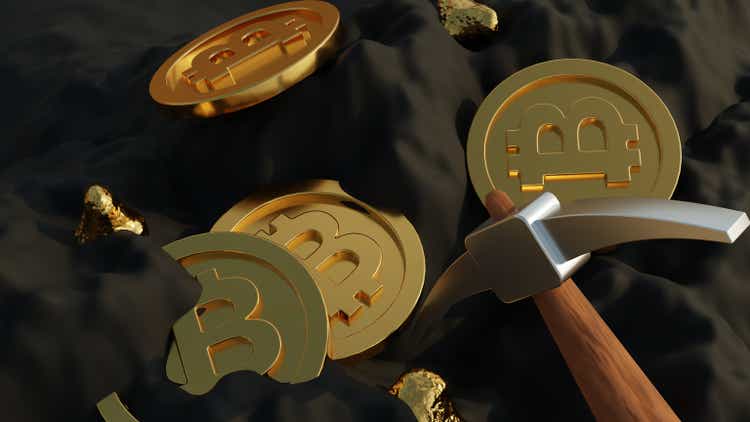Sibani Das
Ironically enough, on Halloween 2023, I ended a long hiatus from SA and posted my thesis on Bitcoin miners, with special attention focused on the Valkyrie Bitcoin Miners ETF (NASDAQ:WGMI). At the time of the article, WGMI was trading at under $10 a share with little to no momentum. Fortunately, those who were brave enough to take the plunge have been rewarded with an outsized gain of over 100%, with the potential for more to come. A few notable recent events, in my view, warrant a reexamination of the thesis to determine if the opportunity has passed or if there are more gains to come.
Bitcoin
The initial foray into the miners was based on the premise that the miners would serve as a beta play on the continued higher move of the underlying asset, Bitcoin (BTC-USD). I viewed the BTC miners in a similar vein to the gold mining industry. The theory held that when the gold (GLD) ran, the miners witnessed by the VanEck Gold Miners ETF (GDX) would outpace the underlying move in the commodity as miner profitability would explode higher.
The BTC/ WGMI thesis has held up remarkably well. On October 31st, BTC traded at $33k, and WGMI traded at roughly $10. BTC is up roughly 75%, while WGMI is up over 120% in the comparable period. An interesting anomaly has opened, with BTC peaking in mid-March, yet the gains in WGMI have accelerated since.
Halving Cycle
BTC underwent its pre-determined halving every 210k blocks on April 19, 2024. The halving vent is notable for two main reasons. For the miners, it is a period of expected pain as the block reward for mining is cut in half. The reduction in block rewards sets off a chain reaction where miners are required to upgrade equipment or face the risk of obsolescence as block rewards fail to cover the cost of energy.
At the time of the halving, the BTC network hash rate was 650 Ehs, a notable peak. The current hash rate of 546 Ehs is a drop of 16%, and more hash rates could come offline as the current hash reward approaches 4.5 cents per Terahash. We do not see revenue and earnings explode higher as miners face a tough go post-halving. We have a change in the thesis as a new element that can boost the miner’s revenue has been uncovered.
AI Winner
The miners and, by extension, WGMI are well positioned to profit from the ongoing build-out of AI infrastructure. Some may postulate this is a bridge too far, yet I can assure you it is not. What does a BTC miner do? They identify cheap, underutilized power sources, typically in remote areas, to build a data center to set up their machines to mine Bitcoin. Miners typically avoid major city centers as the cost of electricity is prohibitive. For example, my home electricity rate is thirteen cents a kWh. If I plug in a 100Ths machine, I can expect to earn $4.55 in BTC rewards (if I can stand the noise and do not get fined for noise ordinance). The cost of mining is $9.55, leaving me with a net loss every day. To make a go of it, a miner would need to procure long-term electricity contracts at 2-3 cents a kilowatt hour.
Coincidentally, the AI build-out requires the same conditions as those witnessed by the hyperscalers, who need to acquire abundant energy quickly. We witnessed the opening gambit of a multi-year bull market in energy, with Amazon (AMZN) acquiring a nuclear power plant to power a data center currently under construction. AMZN dropped $650 million for the plant, who’s to say another competitor with a deep pocket will not step forth and acquire a publicly traded BTC miner? The probable path of least resistance for the miners is to partner with the hyperscalers and offer to manage some of their AI workload at the existing BTC mining facilities. The customer can forgo the cost of building the facility from scratch. In contrast, the miners can now have a new source of high-margin revenue that will offset some of the volatility of the BTC mining industry. An example is the recently announced deal by HUT8 (HUT), a BTC mining veteran. I believe the AI buildout and the recently announced deals are what arrested the anticipated slide in WGMI due to the recent peak in BTC prices.
WGMI Holdings
In my view, the optimal setup is to purchase the index instead of one of two names in the industry. The AI deals signed by some of the smaller cap miners have come out of the blue, whereas the largest player by market cap, Marathon Digital (MARA), is down for the year as the AI potential seems to have passed them by. WGMI has astutely under-indexed them, with MARA the seventh-largest holding. I suggest readers familiarize themselves with the current top holdings vs. my last article to see the dynamism of the industry.
Risk Factors
WGMI earnings are currently tied to the vagaries of the BTC cycle. With the recent drop in the price of BTC due to Mt Gox repayments, there are no guarantees the miners will continue to outperform. In addition, an investor is buying into an ETF that is red-hot and potentially overbought. A nasty pullback can occur at any time, inflicting psychological pain and potential losses.
In addition, the AI buildout may hit speed bumps, with little guarantee that additional hosting deals will be signed. Failure to ink additional deals may have a hard-to-predict material adverse effect on the industry.
With a sharp eye on the potential and a keen awareness of the risk involved, I thank all for reading and good luck!!!

